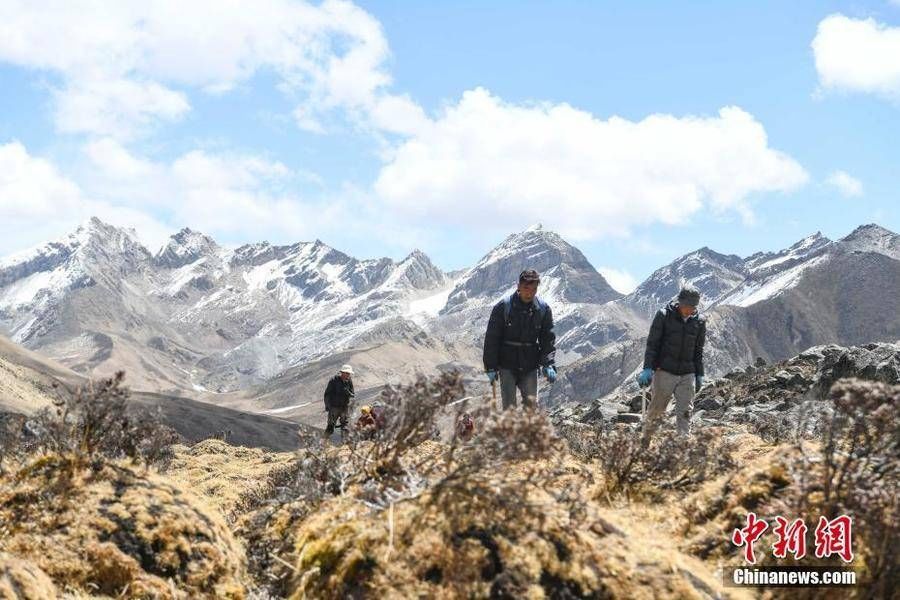In late April, the “soft gold” Cordyceps sinensis, widely distributed on the Qinghai-Tibet Plateau, ushered in the picking season. Sellers have long sensed business opportunities and began to shout on e-commerce platforms, inviting customers at home and abroad to try them.
Cordyceps sinensis is a valuable Chinese and Tibetan medicinal resource. Cordyceps sinensis appeared in ancient Indian literature as early as 3,000 years ago.

The picture shows that on April 21, villagers in Anrao Town, Jiacha County were digging for Cordyceps sinensis in Suonanggou. Photo by China News Agency reporter Gongga Laisong
Picking in the mountains: “soft gold” is a magic weapon for increasing income
Currently, at altitude Cordyceps has begun to be excavated in the relatively low Caoshan Mountains of about 3,000 meters, and for Cordyceps in the area of more than 5,000 meters above sea level, merchants have issued an announcement to accept pre-excavation reservations. In recent years, fresh grass has become a big trend.
Jiajia Township, Jianzha County, Huangnan Tibetan Autonomous Prefecture, Qinghai Province is an important local Cordyceps sinensis producing area. Wa Luo, Secretary of the Party Committee of Jiajia Township, Jianzha County, introduced that a large number of local farmers and herdsmen not only dig locally, but also dig in other states and counties. .”
Farmers and herdsmen slept in the open air during the excavation period, and searched on the ground during excavation, which was physically exhausting. At the same time, they also faced hidden dangers such as lightning, beast attack, and traffic safety. “We signed an agreement, and the staff are responsible for each area to ensure civilized and safe mining.” Wa Luo said.
Tibetan guy Zhaxi Dajie is from Zaduo County, Yushu Tibetan Autonomous Prefecture, Qinghai Province, “the first county of Cordyceps sinensis in China”. “The number of digs varies every year. Last year, thousands of cordyceps were sold for 30,000 to 40,000 yuan. (RMB, the same below).”
Yushu Tibetan Autonomous Prefecture Sanjiangyuan Cordyceps Technology Co., Ltd., Qinghai Regional Director Wang Lei introduced that the company purchases 2,000kg to 3,000kg of Cordyceps in Qinghai every year, through Beijing, Shanghai, Guangdong and other sales points, radiate to both at home and abroad.
According to experts from Qinghai University’s Academy of Animal Husbandry and Veterinary Sciences, the province’s annual reserves of Cordyceps sinensis range from 208 million to 6.399 billion, with an average of 2.232 billion, and the potential economic value is about 3.12 billion to 223.974 billion yuan, with an average of 2.232 billion. 55.805 billion yuan.
According to statistics, the annual output of Cordyceps sinensis in Qinghai Province is about 80 tons to 100 tons, and the annual output value is 18 billion to 20 billion yuan, which benefits millions of farmers and herdsmen, especially in the core production areas, Cordyceps sinensis become the main source of income for farmers and herdsmen.
Artificial Breeding: Or a New Trend
Cordyceps sinensis “the more you dig, the more expensive it is, the more expensive the more you dig”, but the host insects, Cordyceps fungus, precipitation, temperature Such natural factors are the key to affecting the formation of Cordyceps sinensis. Therefore, “artificial breeding” of Cordyceps sinensis was once considered a fantasy. But now, artificially bred Cordyceps sinensis has quietly appeared in the market, and the output should not be underestimated.
Reporters from China News Agency found that in the past two years, researchers have paid more attention to the associated bacteria of wild and artificially bred Cordyceps sinensis and the diversity of soil microbial communities in the habitat, the color change of larvae, the content of active ingredients, and harmful substances. (heavy metals, pesticide residues), etc.
Wang Lei, who has been in the Cordyceps sinensis industry for 20 years, said that as a Chinese and Tibetan medicinal material, Cordyceps sinensis pays attention to its authenticity. Artificially bred Cordyceps sinensis, as a new thing, is relatively cheap, and its differences with wild Cordyceps sinensis should be studied in depth. Research. “If the two are comparable, artificial breeding is a trend, but if there is a gap, it is another matter.”
(China News Agency reporter Zhang Tianfu)